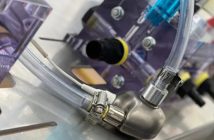Author: Dr Rustom Kanga – iOmniscient
This article was first published in The Australian Security Magazine
The initial research on iOmniscient’s Video Analytics technology began in 1994 and it is therefore seen as the pioneer in this field. It continues to demonstrate its technological lead winning the Global Security Challenge for Crowded Places in 2010 and the IFSEC Award for the Best CCTV Technology in 2011 and having a growing number of implementations in most major countries around the world. A large number of the innovations that we see in the technology today were pioneered by iOmniscient. Here Dr Rustom Kanga, Founder and CEO of iOmniscient and author of the first comprehensive book on video analytics, reminisces on how the technology has changed in recent years and provides insights into where it is going.
Surveillance in the 20th Century
As recently as a few decades ago, visual surveillance depended on the use of human guards. The only way to protect a property was to have a guard who patrolled the area. Even today a physical presence can be extremely valuable as it enables the “Guard” to take immediate action if an unwanted event is detected. In some situations, as in a crowded cafeteria in an airport, a physical presence is perhaps the only way to protect the environment and to deter criminals. This can be regarded as the First Generation of Security.
Over time it became evident that it was not possible to have sufficient guards to cover every environment that had to be secured and this led to the placement of cameras in certain locations. These were essentially eyes that complemented those of the guard and allowed the security team to monitor locations that could not be covered by a physical presence. This was the Second Generation of Security Technology.
Having added “eyes” in the form of cameras, the next step was to record the images. This added “memory” to the system. The early recording systems were based on video tape. This had significant disadvantages in terms of the durability of the media (since video tapes tend to deteriorate quite rapidly with age) and with the inability to access the video footage randomly. This second disadvantage meant that to review an event it was necessary to go through the entire tape sequentially to find the point where the event was recorded. The addition of memory was the Third Generation in Security Technology.
Modern systems tend to use digital random access media such as hard disks which are more durable and where events can be marked and accessed as required rather than sequentially. Moving to random access memory coincided with using IP (Internet Protocol) cameras and the internet for communications. This was the Fourth Generation of Security Technology.
Right through this technological evolution a human was still required to view the video footage and to understand it. These systems were not required to perform any analysis and hence can be viewed as being useful but having no “intelligence”.
Systems with a “memory” can only recall events after they have happened and are useless in preventing an undesirable event or for reacting to it in real time.
As we have seen in recent years there have been a growing number of threats particularly in busy and complex environments, Fourth generation systems just could not cope with these. The need for something better was very evident.
New technologies for the 21st Century
Right to the turn of the century the focus was on recording and video based surveillance systems were only ever used in retrospect to understand the past – to review events after they had occurred.
To be preventive and to be able to react in real time, the security system needed intelligence – intelligence to understand what was happening in the video itself so that the security officer could be notified of a threat/ incident as soon as it happened. Beyond adding eyes and memory to the system, the addition of intelligence added the ability to “think”. It informed the Security Officer about adverse or suspicious events such as, for example, a bag had that been abandoned in view of Camera 65 or a crowd that had gathered suddenly on Camera 220 allowing the Security Officer to focus on events as they occurred and to take immediate remedial action. This can be viewed as the Fifth Generation in Security Technology – the Generation of Video Analytics. Video Analytics provides the ability to respond pre-emptively or at least in real time to events.
At the start of the new millennium, several companies had introduced some basic video analysis.
Virtually all of this initial video analysis (and this is still the case today) was based on Motion Detection. Motion detection involves the comparison of two sequential images to determine if anything has changed. Such technology and all its variations can be made to work reasonably in an empty scene. Today motion detection technology is very common. It is easily available in the public domain and is taught at every second University. Camera and DVR companies often give it away to sell their products.
This technology is also fraught with false alarms because everything that moves (which includes shadows, trees, water and other things) is not necessarily of interest.
iOmniscient decided to embark on a different journey. We decided that to survive in a competitive world we had to do things differently. We developed technology focused on coping with complex, crowded scenes and on minimizing false alarms. One design goal was that all our software had to be computing light. To achieve this we had to develop alternative ways of analysing video using artificial intelligence several of which have been patented.
Developing technology that helped to minimize false alarms was one of the highest priorities as we were of the firm belief that the key to make technology useful was to reduce the number of what are euphemistically known in the industry as nuisance alarms.
And everything we did was focused on coping with crowds as our stipulation was that the most critical security situations occur in crowds. So while others could find an abandoned bag in an empty scene, iOmniscient’s patented non-motion detection could do that in a busy crowd where a thousand people walked in front of it obscuring it for long periods of time. While others could count individuals going through a door we could count the number of people in dense crowds.
And finally we set ourselves the design goal of providing an end to end solution incorporating a comprehensive VMS system as the foundation of the video analytics system making it unnecessary for the user to worry about integrating with a DVR or NVR.
This approach did reap dividends. When iOmniscient launched its first product in 2004 it won the IFSEC Award in the UK for the best new technology. Today it continues to be hailed as the best technology in the industry having just won the Best CCTV Technology Award at IFSEC yet again.
Identification complements Detection
While the focus of most video analytics companies was on detection techniques – methods for detecting gross behaviours – there were other branches of artificial intelligence technology being developed elsewhere for identifying objects. Vehicles were being identified by their license plates and people from their faces.
Traditional methods of License Plate Recognition involved motion loops (metal wires) embedded under roads. When the vehicle passed over them the camera was triggered to take a shot. The image was then usually read by a human and transcribed onto a form. Today video cameras can use their understanding of the video to know that a vehicle needs to be detected, it can do this automatically, recognize the numbers on the plate and compare them with a database to determine if they are authorized or on a blacklist.
Facial Recognition first appeared on the market before the turn of the century. However it was expensive and only accurate in very controlled environments. Therefore it was useful as a biometric tool for applications such as access control. A year ago by introducing Facial Recognition in a Crowd, iOmniscient effectively moved this technology from being useful merely for access control to something that has become a critical element in advanced surveillance systems. This new capability transforms the way that covert surveillance can be performed.
Automated Surveillance
PTZ cameras started becoming more widely used during the past decade in the mistaken belief that they can improve the productivity of security personnel (a concept encouraged by some camera manufacturers who found this to be a useful and profitable product in their portfolio for replacing older products). They certainly are useful in manual operations.
Unfortunately as many organizations have learnt to their dismay, PTZ cameras are easy to defeat when used for automated surveillance. If an event is detected the PTZ camera can be zoomed in to look at the intruder. However smart criminals and terrorists have learnt that sending in a decoy can distract a PTZ camera that zooms in on him ignoring a horde of other events in a neighbouring area. This problem of PTZ cameras was overcome with the introduction of IQ Hawk, another patented technology from iOmniscient which uses detection technology to detect one or more events on a megapixel camera and identification technology to zoom in on the persons or vehicles that caused the event.
…… Continued in The Australian Security Magazine
Don’t miss articles like this – subscribe to The Australian Security Magazine today.





